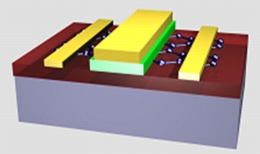Home > Press > Low Noise Top Gate Graphene Transistor is Demonstrated
 |
Abstract:
Graphene, which consists of just a single atomic layer of carbon atoms bound into crystal lattice, is the hottest new material system considered for applications in future electronics and sensors. The properties, which make graphene so desirable for future electronics, are its extremely high electrical and thermal conductivities. For any transistor to be useful for communications or information processing, the level of the electronic low-frequency noise (also referred to as 1/f or flicker noise) has to be reduced to an acceptable level defined by the Hooge parameter. Although modern electronic devices such as cell phones and radars operate at very higher frequencies (GHz range), the low-frequency 1/f noise is extremely important. Due to unavoidable non-linearities in devices and systems, the low frequency noise up-converts to higher requencies, and contributes to the phase noise of the system, thus limiting its performance. The same is true for the proposed applications of graphene as a material for ultra-sensitive detectors.
Low Noise Top Gate Graphene Transistor is Demonstrated
Riverside, CA | Posted on July 22nd, 2009A team of researchers from the University of California - Riverside (UCR) and Rensselaer Polytechnic Institute (RPI) led by UCR electrical engineering professor Alexander A. Balandin built and demonstrated the first top gate graphene transistor, which satisfies the low-noise requirements for graphene practical applications. The transistors were fabricated with electron beam lithography from single atomic layer graphene placed on Si/SiO2 substrates and coated with HfO2 (a new gate dielectric recently adopted by electronic industry). The top gate separated from graphene channel by HfO2 allowed for precise control of electron transport. The combined action of the bottom and top gates allowed the team to investigate the noise sources.
The discovery that electronic noise in the properly designed top-gate graphene transistors can be reduced to low levels came as a bit of a surprise. Graphene is just a single atomic layer of material. When it is embedded between two oxide layers (SiO2 and HfO2) its electronic transport and noise are strongly affected by defects and impurities in the oxides, which act as traps for electrons and contribute to noise. The analysis performed by UCR - RPI team suggests that the flicker noise in graphene transistors originates from the carrier number fluctuation in the device channel rather than from the mobility fluctuations. The obtained experimental date also indicates that the noise level can be reduced even further with improvements in graphene device fabrication technology. The demonstration of the low-noise top-gate graphene transistors is a crucial requirement for all proposed communication, digital and sensor applications of graphene.
The results are published in Applied Physics Letters.
####
For more information, please click here
Contacts:
Alexander A. Balandin, PhD
Professor, Department of Electrical Engineering
Chair, Materials Science and Engineering Program
Director, Nano-Device Laboratory
University of California - Riverside
Riverside, CA 92521 USA
Copyright © University of California - Riverside
If you have a comment, please Contact us.Issuers of news releases, not 7th Wave, Inc. or Nanotechnology Now, are solely responsible for the accuracy of the content.
| Related News Press |
News and information
![]() Researchers develop molecular qubits that communicate at telecom frequencies October 3rd, 2025
Researchers develop molecular qubits that communicate at telecom frequencies October 3rd, 2025
![]() Next-generation quantum communication October 3rd, 2025
Next-generation quantum communication October 3rd, 2025
![]() "Nanoreactor" cage uses visible light for catalytic and ultra-selective cross-cycloadditions October 3rd, 2025
"Nanoreactor" cage uses visible light for catalytic and ultra-selective cross-cycloadditions October 3rd, 2025
Chip Technology
![]() Lab to industry: InSe wafer-scale breakthrough for future electronics August 8th, 2025
Lab to industry: InSe wafer-scale breakthrough for future electronics August 8th, 2025
![]() A 1960s idea inspires NBI researchers to study hitherto inaccessible quantum states June 6th, 2025
A 1960s idea inspires NBI researchers to study hitherto inaccessible quantum states June 6th, 2025
![]() Programmable electron-induced color router array May 14th, 2025
Programmable electron-induced color router array May 14th, 2025
Discoveries
![]() Researchers develop molecular qubits that communicate at telecom frequencies October 3rd, 2025
Researchers develop molecular qubits that communicate at telecom frequencies October 3rd, 2025
![]() Next-generation quantum communication October 3rd, 2025
Next-generation quantum communication October 3rd, 2025
![]() "Nanoreactor" cage uses visible light for catalytic and ultra-selective cross-cycloadditions October 3rd, 2025
"Nanoreactor" cage uses visible light for catalytic and ultra-selective cross-cycloadditions October 3rd, 2025
Announcements
![]() Rice membrane extracts lithium from brines with greater speed, less waste October 3rd, 2025
Rice membrane extracts lithium from brines with greater speed, less waste October 3rd, 2025
![]() Researchers develop molecular qubits that communicate at telecom frequencies October 3rd, 2025
Researchers develop molecular qubits that communicate at telecom frequencies October 3rd, 2025
![]() Next-generation quantum communication October 3rd, 2025
Next-generation quantum communication October 3rd, 2025
![]() "Nanoreactor" cage uses visible light for catalytic and ultra-selective cross-cycloadditions October 3rd, 2025
"Nanoreactor" cage uses visible light for catalytic and ultra-selective cross-cycloadditions October 3rd, 2025
|
|
||
|
|
||
| The latest news from around the world, FREE | ||
|
|
||
|
|
||
| Premium Products | ||
|
|
||
|
Only the news you want to read!
Learn More |
||
|
|
||
|
Full-service, expert consulting
Learn More |
||
|
|
||








